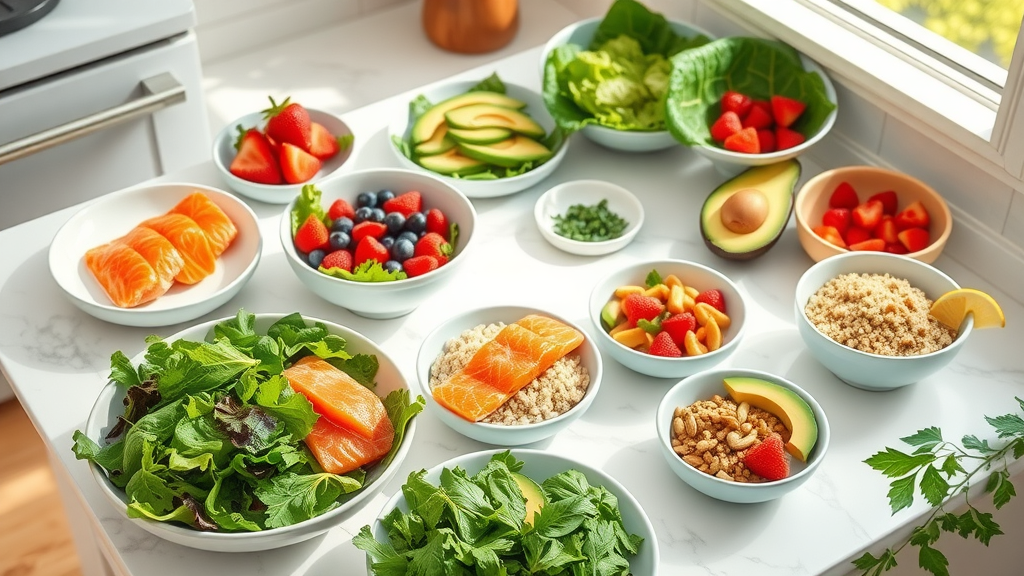Did you know that over 80% of women report feeling exhausted most days—not from work or family challenges, but because of what they’re eating? The real magic behind consistent vitality, sharp focus, and glowing wellness isn’t another cup of coffee or a miracle supplement; it’s harnessing the power of healthy eating. In this guide, you’ll discover surprising truths, clear strategies, and lasting food habits designed uniquely for every woman who is ready to thrive.

Startling Facts About Healthy Eating Every Woman Should Know
"Did you know that over 80% of women report feeling fatigued due to poor dietary choices? Healthy eating can transform your energy—and your life."
For women everywhere, unlocking better health and increased energy often begins with the food on your plate. According to the dietary guidelines for Americans—published by the federal government—nutrition plays a crucial role in everything from mood to cardiovascular health. In the United States, statistics show higher rates of fatigue, high blood pressure, and lifestyle-related illnesses correlate directly with poor eating habits. The truth is, what you eat impacts not only your body, but also your mind and daily performance.
Many women are surprised to learn that making healthier choices doesn’t just stave off hunger—it actually improves vitality, concentration, and resilience against stress. Understanding how healthy food choices can reduce the risk of heart disease, improve blood pressure, and help you feel full for longer is empowering. More importantly, these changes are sustainable and accessible for women at every stage of life.
What You'll Learn: The Power of Healthy Eating for Women's Wellness
- How healthy eating boosts energy and vitality
- The top 10 healthy foods every woman should include
- Simple steps to start eating healthier today
- Understanding saturated fat and its impact
- The 3 3 3 rule for sustainable healthy eating habits
By the end of this guide, you’ll have practical, step-by-step advice that makes healthy eating almost effortless. From uncovering which foods pack the biggest nutritional punch to making daily routines stick, get ready to transform how you eat—and how you feel.
What Is Healthy Eating? A Woman’s Guide to Lasting Wellness
Defining Healthy Eating for Women

Healthy eating is more than just a trend—it's a lifestyle that emphasizes the importance of balancing nutrients to sustain a healthy body and mind. At its core, healthy eating means choosing foods and drinks that give you a good source of vitamins and minerals, while limiting added sugars, saturated fats, and heavily processed foods. The dietary guidelines for Americans recommend prioritizing fruits and vegetables, whole grains, lean proteins, and healthy fats.
For women, these choices become even more critical as our nutritional needs shift throughout life. Healthy eating not only helps you maintain a healthy weight, but also supports hormonal balance, bone strength, and energy production. By reading food labels and staying informed about what you consume, you can make healthier choices that are tailored to your unique needs at every stage—young adulthood, pregnancy, menopause, and beyond.
How Healthy Eating Differs for Women Across Life Stages
A woman’s nutritional requirements aren’t static—they shift dramatically from adolescence, to reproductive years (including pregnancy and breastfeeding), and into menopause. For example, younger children and teens need extra calcium and iron to support growth and development. Women in their 20s and 30s may need more folic acid and protein for reproductive health, while post-menopause, heart and bone health take center stage.
Understanding these shifts empowers you to make healthy choices that deliver the right nutrients when they’re needed most. By focusing on a healthy diet—with a variety of fruits, vegetables, whole grains, and balanced fats—you lay the groundwork for energy, protection against disease, and lifelong vibrancy. This adaptability is the essence of healthy eating for women.
The 10 Most Healthy Foods Women Need for Energy
| Healthy Food | Main Benefits | Key Nutrients | Easy Serving Ideas |
|---|---|---|---|
| Leafy Greens | Boost energy, support heart health, aid digestion | Iron, Vitamin K, Folate, Fiber | Salads, smoothies, stir-fry |
| Fatty Fish | Fuel brain and heart, reduce inflammation | Omega-3s, Protein, Vitamin D | Grilled salmon, tuna wraps, sushi bowls |
| Nuts and Seeds | Feel full longer, support hormones, boost mood | Healthy fats, Protein, Magnesium | Trail mix, chia pudding, almond butter toast |
| Whole Grains | Sustain energy, stabilize blood sugar, aid gut health | Fiber, B Vitamins, Selenium | Quinoa bowls, oatmeal, brown rice stir fry |
| Berries | Antioxidant boost, protect against heart disease, skin health | Vitamin C, Fiber, Antioxidants | Fresh fruit snack, smoothie, oatmeal topping |
| Legumes | Plant protein, stabilize blood sugar, improve digestion | Protein, Iron, Fiber, Folate | Chickpea salad, lentil stew, hummus dip |
| Yogurt | Gut health, bone strength, immune support | Probiotics, Calcium, Protein | Breakfast parfait, tzatziki sauce, on-the-go snack |
| Eggs | Complete protein, support brain health, increase satiety | Protein, Choline, B Vitamins | Boiled, scrambled, frittatas |
| Sweet Potatoes | Sustained energy, promote vision, antioxidant support | Beta-carotene, Fiber, Vitamin C | Roasted, mashed, fries |
| Avocado | Healthy fats, improve absorption, boost mood | Monounsaturated fats, Potassium, Fiber | Toast, salad topper, guacamole |
- Leafy greens
- Fatty fish
- Nuts and seeds
- Whole grains
- Berries
- Legumes
- Yogurt
- Eggs
- Sweet potatoes
- Avocado

Each of these foods provides a powerful nutritional advantage, ensuring that women not only meet but exceed their daily energy and nutrient requirements. Rotating these healthy foods into your meals guarantees you’re fueling your body with what it needs most to fight fatigue, stay focused, and protect against chronic diseases like heart disease and high blood pressure. Remember, even simple swaps—like choosing fat milk alternatives or adding more fruits and vegetables—make a substantial difference in daily energy levels.
The Role of Saturated Fat in Healthy Eating for Women
Saturated Fat: Friend or Foe?
Saturated fat, commonly found in full-fat dairy, red meat, and many processed foods, has long been a topic of debate. While small amounts can be part of a balanced diet, too much saturated fat may contribute to weight gain, raise cholesterol, and increase the risk of heart disease—a primary concern for women as they age. The dietary guidelines for Americans recommend limiting saturated fat to less than 10% of your total daily calories.
It’s important to recognize that not all fats are created equal. Swapping saturated and unsaturated fats—like replacing butter with olive oil or enjoying avocados instead of processed spread—creates a healthier choice for long-term wellness. Reading food labels can help you choose foods and drinks with healthier fat profiles, thus keeping your heart, brain, and hormones in balance.
How to Balance Fats for Optimal Women’s Health
Building a healthy eating plan means focusing on variety and moderation. Women should prioritize sources of unsaturated fats (such as fatty fish, nuts, and seeds) to help reduce high blood pressure and decrease the risk of heart disease. These fats, when chosen over saturated fat, also help you feel full longer—reducing cravings and making it easier to sustain a healthy diet.
Examine food labels for trans and saturated fat content, especially in packaged and added-to-foods products. Choose low-fat dairy and lean meats, reserve red meats for occasional meals, and savor plant-based sources of healthy fat regularly. These habits support hormonal balance, provide steady energy, and help manage your weight and cholesterol over time.
How Beginners Can Start Eating Healthier: A Step-by-Step Approach for Women
Simple Swaps to Make Healthy Eating Easy
Small changes lead to big results! If you want to start a healthier diet, forget about extreme restrictions or complicated meal plans. Instead, focus on simple swaps that fit easily into your routine. These swaps allow you to improve nutrition without feeling deprived and make eating habits stick, especially for beginners.
- Replace soda with infused water or herbal tea
- Choose whole grain bread instead of white bread
- Snack on nuts or fruit instead of chips

Each swap above adds valuable nutrients and healthier choices to your daily meals. For example, swapping soda for infused water cuts sugar in your diet, lowering the risk of high blood pressure and supporting natural hydration. Opting for whole grain bread over white adds fiber, which is key for feeling full and steady energy. Choosing nuts or fresh fruit as snacks replaces empty calories with vitamins, minerals, and healthy fats. Over time, these practices not only strengthen your body but also train your taste buds to naturally prefer healthy food.
Understanding the 3 3 3 Rule for Eating Healthy as a Woman
Applying the 3 3 3 Rule to Everyday Meals

The “3 3 3 rule” is a simple, memorable guideline for structuring meals, especially helpful for busy women seeking consistency. The rule? Aim for 3 servings of fruits and vegetables, 3 sources of lean protein, and 3 servings of whole grains per day. This approach ensures variety and covers key nutrients outlined in the dietary guidelines for Americans.
By following the rule, you distribute healthy food options throughout the day. For example, breakfast can feature whole grain toast, yogurt, and berries; lunch might be a leafy green salad with grilled chicken and quinoa; dinner could include fish, roasted sweet potatoes, and a vegetable medley. Using this rule simplifies meal planning and keeps you on track for lifelong healthy eating success without counting every calorie.
Healthy Food Choices: Meal Planning for Women’s Success
Balanced Meal Ideas Packed with Healthy Food
Planning ahead is one of the most powerful steps you can take for sustained healthy eating. Balanced meals don’t mean bland or boring—they mean thoughtfully pairing foods for taste and nutrition. Try starting your day with oatmeal topped with fresh fruit and nuts. Your lunch could be a colorful lentil or chickpea salad paired with leafy greens and a hard-boiled egg. For dinner, consider a simple baked salmon with sweet potatoes and steamed vegetables.
Snacks can play a crucial role too. Think sliced avocado on whole grain toast, Greek yogurt with berries, or a handful of almonds with an apple as a good source of nutrients. When your fridge and pantry are stocked with these healthy foods, making a healthier choice becomes easy, supporting positive eating habits over time.
Meal Prep Tips for Busy, Successful Women
For professional women juggling demanding schedules, meal prepping is a true game-changer. Start by mapping out your week’s meals and snacks. Prepare staple ingredients—like quinoa, roasted vegetables, and grilled chicken—in advance, and store them in glass containers for freshness.
Reserve a couple of hours each week for prep time. Use checklists, color-coded containers, or even digital reminders to stay organized. Portion out meals according to the 3 3 3 rule, so everything is ready to go. This not only saves time but ensures you always have a healthy food option on hand, reducing the temptation to make unhealthy choices when life gets hectic.
Watch: Quick Meal Prep Strategies for Healthy Eating
Women & Wellness: The Long-Term Benefits of Healthy Eating
Increased Energy and Focus

Consistent healthy eating does more than just keep your body in top form—it sharpens your mind and keeps you energized through the busiest days. Foods rich in complex carbohydrates, healthy fats, and lean protein release energy steadily, unlike sugary snacks or processed foods that spike and crash your blood sugar.
Many women notice clearer thinking, steadier focus, and an improved ability to multitask when nourishing their bodies with nutrient-dense meals. Whether in a meeting, at home with family, or powering through a workout, this energy transformation comes directly from prioritizing healthy food throughout your day.
Improved Mood and Hormonal Balance
The link between nutrition and emotional wellness is undeniable. Diets high in processed foods and saturated fat are often associated with increased mood swings and hormonal imbalances, while diets informed by the dietary guidelines for Americans—rich in fruits, vegetables, healthy fats, and lean proteins—help keep mood steady.
Eating patterns packed with omega-3s, for instance, support brain health and reduce symptoms of depression in women. Meanwhile, regular meals with a balance of healthy carbs like whole grains can smooth out hormonal fluctuations tied to stress or the menstrual cycle. The more consistently you make healthy food choices, the more likely you are to feel emotionally—and physically—balanced.
Disease Prevention and Longevity
Long-term healthy eating is your best defense against chronic diseases. Study after study points out that women who choose whole foods over highly processed options lower their risk of heart disease, high blood pressure, certain cancers, and type 2 diabetes. Nutrient-rich diets with lower saturated fat also contribute to healthy bones, glowing skin, and a resilient immune system.
"A woman who prioritizes healthy eating is investing in her present vitality and future strength."
Making these choices today is an investment in decades of well-being, enabling you to stay active, independent, and vibrant well into the future.
People Also Ask: Common Questions About Healthy Eating for Women
What are the 10 most healthy foods?
The 10 most healthy foods for women focus on nutrient density, heart health, and stable energy: Leafy greens, fatty fish, nuts and seeds, whole grains, berries, legumes, yogurt, eggs, sweet potatoes, and avocado. These foods are rich in vitamins and minerals, fiber, protein, and healthy fats, making them invaluable for supporting a woman’s wellness and fighting fatigue.
How do beginners start eating healthier?
Beginners should start with simple, sustainable swaps—such as drinking infused water in place of soda, choosing whole grain options over processed grains, and snacking on nuts or fresh fruit instead of chips. Focus on learning to read food labels, planning meals ahead, and sticking with the 3 3 3 rule. Small, consistent changes build lasting healthy eating habits.
What is eating healthy?
Eating healthy means consuming a variety of foods and drinks that nourish your body, provide adequate vitamins and minerals, and avoid excess sugars or saturated fats. It's about balance—choosing fruits, vegetables, lean proteins, healthy fats, and whole grains most often, and limiting highly processed or added-to-foods items.
What is the 3 3 3 rule for eating?
The 3 3 3 rule recommends eating three servings each of fruits/vegetables, lean proteins, and whole grains daily. This method keeps meals balanced, making it simple to meet nutritional needs, feel full, and avoid overeating or nutrient gaps.
FAQs: Healthy Eating Tips for Women
-
Can healthy eating improve women’s mental health?
Absolutely! Healthy eating stabilizes mood, boosts focus, and supports better emotional health by delivering critical nutrients for brain function. -
How does healthy eating affect women’s skin?
Nutrient-rich foods, especially those with antioxidants and healthy fats, promote clearer, healthier skin and may reduce acne and signs of aging. -
What’s the best way to overcome sugar cravings?
Replace sugary foods and drinks with natural options like berries, bananas, or a small piece of dark chocolate. Eating balanced meals with fiber, protein, and healthy fats helps keep sugar cravings at bay.
Key Takeaways: Healthy Eating for Energy and Success
- Healthy eating is essential for lasting energy, focus, and women’s wellness
- Incorporate a variety of healthy foods—especially leafy greens, fatty fish, and berries
- Understand and balance saturated fat intake
- Follow practical rules like the 3 3 3 rule for easy consistency
- Empowerment begins with the right nutrition
Ready to Thrive? Subscribe for More Strategies on Women’s Healthy Eating and Lifelong Success
Subscribe for more strategies on how to be a successful woman in every area of your life: http://spotlightonyoursuccess.com
Watch: Unlock the Secrets of Healthy Eating: Nutritionist Tips for Women
Healthy eating is the key to unlocking limitless energy, confidence, and lifelong wellness—one delicious bite at a time.
 Add Row
Add Row  Add
Add 




Write A Comment